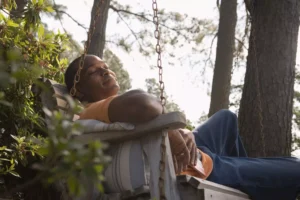Shannon was eager to share the song she’d just learned with her 21-year-old sister Katie. As Shannon strummed her guitar, Katie sang these words with her sweet, soft voice:
I stand to praise You but I fall down on my knees, My spirit is willing, but my flesh is so week … I feel Your arms around me as the power of your healing begins. Your spirit moves through me like a mighty, rushing wind.[note]”Light the Fire,” Copyright 1987, Bill Maxwell, Bloodsmith Music.[/note]
After they sang the song a few times, Shannon went to bed. But that night, Katie didn’t sleep at all. As her family slept, she was talking on the phone, telling a few close friends how much they meant to her.
The next morning, she took her own life.
Katie died three years ago this April, but the grief is still fresh for Shannon. “The pain is just as real as it was when it first happened.” she says. “I believe that God has healed me immensely, but I still cry as much now as I did then, if not more. It was the most painful, the most defining moment of my life … Not an hour goes by that I don’t think of her.”
Those who have survived the suicide of a loved one understand that grieving is a journey through brokenness. “Suicide doesn’t end pain,” says Anne-Grace Scheinin in the book Grieving a Suicide by Albert Y. Hsu. “It only lays it on the broken shoulders of the survivors.”
So what do the survivors do? Here’s some wisdom from people who’ve had firsthand experience with suicide, and have found constructive ways to sort through their own grief and to bring healing to others.
Don’t Try to Ignore It
Suicide devastates a community. University of Chicago pastor Daphne Burt says that when a suicide happens on a university campus, people like roommates, resident heads, and friends need extra care. Those who haven’t been directly affected by the event need to support those closest to the pain. Burt recommends small acts of kindness, like just being thoughtful enough to ask how a person is doing. “They may say, ‘I’m fine,’ but it’s nice to be asked,” Burt says.
Robert Randolph, dean of students at MIT, has faced an average of one suicide a year in his 25 years there. Supporting bereaved family and friends is critical, he says, not only immediately after a suicide, but also as the anniversary of the event rolls around. “It is important not to expect people to heal quickly,” Randolph says.
It can be hard to know what to say or do after a suicide, but O’Neill says that one of the worst approaches is to try to ignore the event. The silence surrounding a suicide can be deafening for the bereaved. “I do enjoy talking about my sister,” she says. “The fact that she had a tragic death doesn’t mean that we can’t celebrate her life.”
Prayer picks up where words leave off. After Shannon O’Neill’s sister died, her youth pastor took her out, prayed with her and let her cry. And then he said something she will never forget. “At this stage in your life, you can either run to God, or you can run from Him,” he says.
“I like to think that God ran to me,” O’Neill says.
Write, Rage, Speak
Journaling has been helpful for Shannon. She uses her journal to capture memories and feelings. She also records her prayers there, and is often amazed at God’s responses to her. The pages of her journal help Shannon see how far she has come in the healing process, and memories of her sister pepper the pages.
Being honest about your emotions is critical to the healing process. Randolph recommends taking all your feelings to God, including rage. “Don’t be afraid of being angry. God can handle our anger,” he says. “It may be time to have some hard conversations with Him about why this happened.”
Pastor Daphne Burt suggests some concrete actions to help get the rage out. “I’m a big believer in throwing eggs at trees,” she says. “They make a big smack when they hit, and eggs don’t fly straight, so they make you laugh.”
For Shannon, hearing the accounts of other people who lost friends or family members to suicide has decreased her feelings of isolation. She’s open about her own story, because when people hear it, they seem to be better able to share theirs. “I believe that God comforts us so that we can comfort others,” she says.
On a women’s retreat she recently attended, Shannon shared her story — and two other women who had been coping with post-suicide pain had the courage to open up about their own lives. “You see the pain and you can relate to it,” she says. “When you hear other people’s accounts, there is a depth of shared understanding that goes beyond words.”
Get Perspective
After a suicide takes place at MIT, Randolph says the university responds by making resources available to students, especially professional counselors and campus ministers. These people help students work though their shock and get a grip on guilt. Counselors can reflect back a corrective vision, helping grieving students get in touch with reality.
Ultimately we must surrender even our unfinished business to God. “We’ve got to understand that even when there are things we’ve left undone, we can still be forgiven,” Randolph says. It is also important to realize that the person who died ultimately made their own decision. “A university can do everything in their power and [still] not stop a suicide,” Randolph says.
Over the years, Shannon has gained perspective on Katie’s suicide. “I don’t think that the person who is about to commit suicide understands the pain that they will afflict on their loved ones,” she says. “It really wasn’t about me or anybody she knew. It was very much a struggle she was fighting with herself. The strength of the conflict is so great that some people end up killing themselves.”
More than 2,000 people attended Katie’s wake. Shannon was amazed, moved and saddened to see how many lives her sister had touched in her 21 years on earth. In the suicide note she left, she apologizes more than a dozen times to people she named. But then she wrote: “To those not on this list. I’m sorry you never took the time to know who I was.”
For those who did know who she was, grieving her death has been a long and difficult process. “You feel like you’ve been broken into a million pieces and you can’t put yourself back together,” Shannon says. But as she pages through her journal, she sees that even in the midst of her own brokenness, God strengthens her. “Being broken and weak is not something that I need to rectify,” she says, echoing Paul’s words in 2 Corinthians 12:10. “When I am weak, then I am strong.”
Copyright 2003 Jenny Schroedel. All rights reserved.









